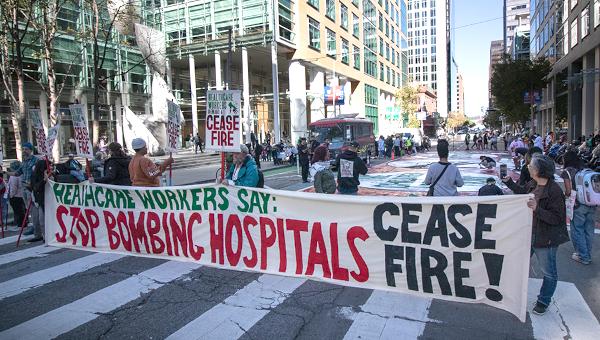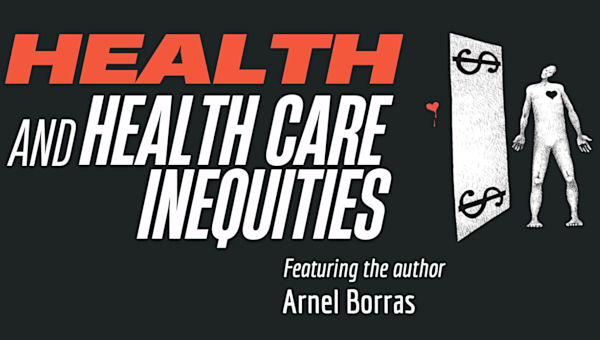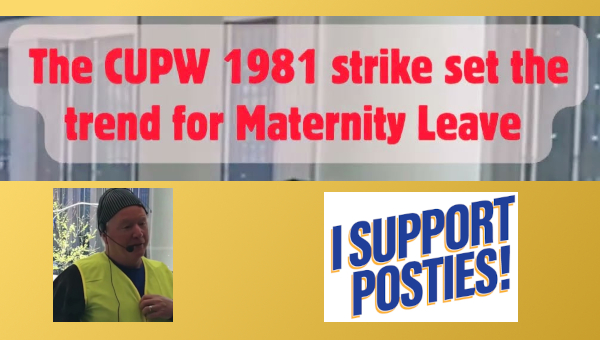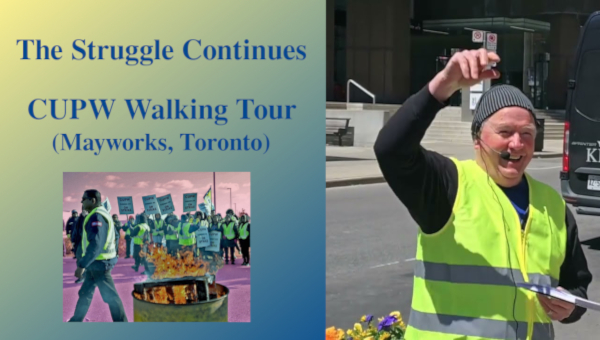Strategy, the Movement and Power: Debating Labour and Community Organizing
Two recent books, Labor Power and Strategy and Power Concedes Nothing, speak to the urgency of our times – the sense of danger, the sense of possibility, the need to grasp the moment. The fact that these are each collective efforts with multiple authors providing perspectives based on different realms of engagement is a reminder that only by drawing broadly from all streams of activism will we be able to defeat the fascist danger which threatens us all, be able to overcome the fragmentation and destruction which capitalism in its neoliberal phase is imposing on working people, on society at large. Yet the two books reflect strikingly different frameworks as the following quotes make clear.
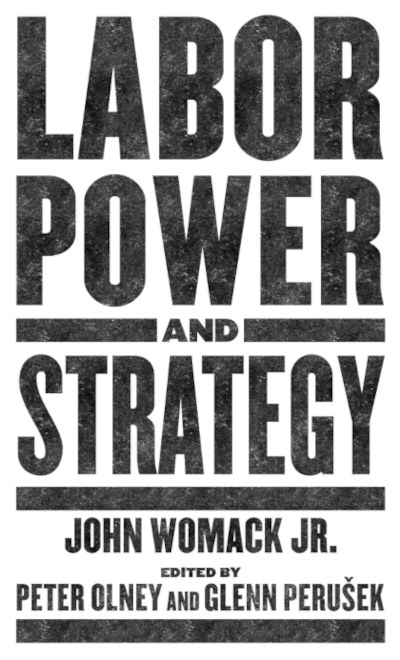
The overarching perspective informing the essays in Labor Power and Strategy is put forward in an introduction by Glenn Perušek, faculty member at the Building Trades Academy at Michigan State University and former director of the Center for Strategic Research at the national AFL-CIO:
“The labor left sees building workers’ power as starting with existing organizations – mobilizing union members in contract and organizing campaigns. This activism needs to blend into broader solidarities – with other unionists, other workers, and other popular interests. Organizing the unorganized must be a top priority. Building active, member-controlled and member-mobilizing unions, integrally connected with their communities, striving for good-paying jobs for all amounts to movement unionism. … Building strong, active unions also requires a comprehensive research and planning process. … Finally, some conception of aspirational goals – politics in the broadest and most positive sense – must infuse labor. A revitalized labor movement needs to be part of an overall multiform movement for social justice.”1
The discussion which follows focuses on how to bring about that revitalization and realize in practice the potential power workers hold. The contrasting emphasis of Power Concedes Nothing is expressed by Alicia Garza, principal at Black Futures Lab and co-founder of the Black Lives Matter Global Network, in her essay concluding the volume:
“For the last two decades, the US left has been forced to reckon with race in a new way; none more salient than the push to address and engage with the impacts of racial capitalism and state-sanctioned violence. … Marginalized communities largely led this push and moved the US left to a reckoning that is transforming the left itself. With respect to electoral organizing, segments of the US left are pushing beyond a strategy of nonengagement to using electoral organizing as defense, with an eye on long-term power-building. While still certainly uneven, the engagement of leftists of color in the fight to claim the country’s politics is a significant development, one that must become more than a trend. It must become a lifestyle. In order to build and seize power and transform how power operates, we must take electoral engagement even further to incorporate electoral strategies that shape our larger fights and help us win.”2
Although the core anti-capitalist, racial and social justice outlook informing both books overlap, the divergence between them is palpable. Perhaps having the two books “talk to each other,” we can uncover paths to a convergence.
Strategic Power at the Workplace
Labor Power is built around an extensive interview with John Womack Jr. (a retired professor of Latin American History and Economics at Harvard) conducted by Peter Olney (former director of organizing for the International Labor and Warehouse Union) in which the work’s key point is made: Workers need to understand the structure of business in order to locate management’s vulnerabilities and then attack those in order to win a particular strike or organizing campaign. Being strategic in this sense – and not being sidetracked by non-strategic struggles notwithstanding the moral importance and social meaning these might have – is of particular importance because the weakening of organized labor in the United States (and globally) the past four decades has led to the concentration of capital in ever fewer hands, growth of massive inequality, and a loss of popular democratic power. The current upsurge of union organizing and strikes raises the possibility of overcoming that weakness, but, Womack posits, militancy without direction will be unable to shift power relationships.
Weakness and decline did not occur because of happenstance. Capital reshaped industrial production through sets of policies imposed under the rubric of neoliberalism, in part to overcome limitations imposed on management “freedom” that union organizing had previously established by way of a post-World War II “social contract.” The success of that restructuring was due to a long-term strategic approach largely absent from organized labor. Globalization combined with “just-in-time production” has meant that production is scattered in multiple smaller units – quite unlike the enormous factories of the past where manufacturing was integrated at central locations and large inventories were maintained to weather downturns and strikes. That means shutting down any one site may not have the impact such an action might have had during the time of the rise of industrial unionism. On the other hand, production is far more dependent than in the past on regional, national, international supply chain links – and it is at the point of those links where worker power can be best exercised to leverage far-reaching change. As Womack explains:
“Let us set aside labor’s political, legal, and other kinds of struggles. These all take their own kinds of strategic analysis, planning, and action. If we focus here on campaigns of struggle along supply chains, I think there is only one kind of study for them, to find the industrially and technically strategic weaknesses in the chains.”3
The logic here applies whether the conflict is restricted to a contract dispute or a demand for recognition, or whether the conflict takes place as part of a wider confrontation over working-class rights. And while this directly highlights the importance of workers in transport industries, a granular analysis can show how workers in tech or services, manufacturing or agriculture, can similarly find points of vulnerability at the heart of capital’s power. Organizing at Amazon, for example, rather than being aimed at every site where the company does business, is better focused on warehouse hubs that can disrupt a whole distribution chain. Finding the particular “choke point” is not only a political question, it’s also a technical question; Womack argues that the ability to do strategic research is vital to labor organization. Yet that is one side of the equation – workers equally need to cultivate a spirit of resistance and defiance, that is essential to any strategy to exercise power. Womack explains:
“Those teachers [striking in West Virginia] confirmed to me yet again that over the last forty-odd years pro-labor liberals have gone wrong in constant appeals to indignation or pity for workers, appeals for feelings to help victims. What works with working people is courage in action, the brave display of power. Once they see somebody acting forcefully in justice, they’re more likely to follow. You see solidarity;”4 adding, “ … their public display of independent power and their public proof of the merits of their cause are the main lessons for labor in general now.”5
The strength of this understanding is that it redirects labor thinking to being concrete rather than relying on sentiment or unfocused militancy. Management’s view of “labor problems” relies on a realistic assessment of what is needed to maximize profits (i.e. how to maximize control over the workforce) within prevailing conditions; labor can do no less by way of response if it is to regain the initiative. Key to doing so means recentering unionism back at the point of production, contrary to the drift over past decades in which comprehensive campaigns focusing on consumers, students, stockholders, the media, the general public) have taken center stage. Important as these are, they tend to remove leadership away from the involved workers and instead give greater importance to those organizing in peripheral spheres, with strikers or organizing workers playing a secondary role. For Womack, the center of any challenge to existing power has to come from people who are impacted, to those workers defending their rights. That is where the intersection between strategic knowledge and strategic action can lie.
There is a danger, however, in the way Womack poses the issue of organizing and power, for by focusing on those sections of the labor force who hold power based on their location in the production process, there is a failure to fully appreciate the necessity to engage all workers irrespective of whether or not they are at a choke point. Moreover, a conception of organizing that over-relies on expert research can underestimate the initiatives working people take on their own – as, for example, treating “hot shops” where workers show a readiness and willingness to organize as a distraction if it isn’t “strategic” as if strategy could be developed that ignores or overrides decisions working people make on their own behalf. Finally, management isn’t passive; the very factors that can enhance labor power can also make capital more determined to undermine the basis of that strength.
This is a critique a number of the commentators in Labor Power make; as a collective enterprise, the book provides a look at class struggle from differing perspectives. A particularly cogent example can be found in a response by Katy Fox-Hodess (lecturer in Work, Employment, People and Organizations at the University of Sheffield) in which she examines the power of dockworkers – as strategic a workforce as one can find in world of globalized production chains. Citing examples from Portugal and Chile, she notes that whenever victory was attained, it was dependent on alliances with “non-strategic” workers be they students, be they the unemployed. Fox-Hodess writes:
“ … Power flows in multiple directions across multiple dimensions – economic, social, and political – in conflicts between capital and labor. The more strategic the industry, the more likely it is that the capitalist state will intervene. As a result, labor movement revitalization will require understanding not only how to find and take advantages of vulnerabilities in the technical division of labor but also how to find and take advantage of economic, social, and political vulnerabilities within the capitalist totality. This will by necessity require a clear understanding of the forms of power each group of workers may offer and a clear understanding that success will come through articulating and combining powers across multiple dimensions, suggesting the need to rethink hierarchies that privilege the technical over the social and political.”6
Strategic Power in the Electoral Arena
The subtitle of Power Concedes Nothing – “How Grassroots Organizing Wins Elections” – serves notice that virtually all (if not all) the essays maintain a clear focus on the danger of authoritarian reaction and the need to build a multi-racial alliance that contests for political office around maintenance and extension of democratic rights. Each of the book’s contributors see the necessity of making the defeat of the Trump (and Trump-inspired) fascist danger a priority through electoral activity and the complementary necessity of building power through mobilizing heretofore excluded communities. Unity built within and between communities subjected to systemic oppression is thus at the core of any strategy to build wider unity around democratic rights and social justice within our country as a whole. Union struggles are part of the picture but there is little about workplace mobilization, labor-management conflict or internal union divides – nor, for that matter is social justice organizing unconnected to the electoral arena given much attention. Rather, the priority is consistently on how to win elections and gain strength in government sufficient to implement public policy changes that attack poverty and inequity.
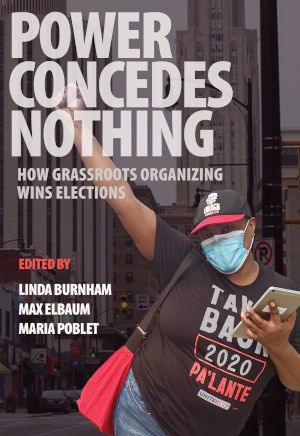
Doing so, the authors of the book contest the view that voter mobilization is not foundational for systemic change (a possible implication of Womack’s conception of organizing). Addressing that outlook directly, National Domestic Workers Alliance Executive Director Ai-jen Poo and National Research Director Linda Burnham in an essay on the “get out the vote” mobilization of domestic workers during the 2020 elections, contest misconceptions that minimize the radicalizing impact election campaigns can have:
“There is debate within the social justice left about whether electoral organizing is ‘transformative’ or not. The logic of on-going issue-based and constituency-based organizing is very different from that of electoral organizing … When done well, it engenders a transformation in consciousness from apathy to concern about particular grievances to an understanding of the dynamics of broader social and economic inequities…
“… [On the other hand] to get millions to flip the switch from non-voting to voting – isn’t that transformative? The domestic worker movement mobilized thousands of canvassers and phone bankers in active defense of democracy – isn’t that transformative? … Their work centered the political power of women of color in a system designed to minimize and negate that power. The rhythm and metrics and subjective feel of the work are different from grassroots organizing. But that too can be transformative.”7
What gives salience to this connection is that existing political and legal institutions (let alone ideological and cultural narratives) have undermined the ability of popular movements to move beyond resistance toward implementation of alternatives that people can see and feel in daily life. Focusing on governing office provides a means to overcome limitations that inhibit the ability to shift public policy toward economic and racial justice, a means to create alternative structures of power in the moment when challenges of environmental destruction, violence, poverty, inequality and declining quality of life are everywhere apparent.
Most of the essays and interviews that comprise Power Concedes Nothing provide a close-eyed view of how the authors engaged various communities to put such an electoral orientation into practice. Initiatives such as these do not take place in isolation, rather, they share an overarching conception of systemic change. Maurice Mitchell, National Director of the Working Families Party, expressed the underlying aim of left engagement in mainstream politics in an article reviewing the course of the 2020 presidential primaries and general election:
“Neither of the progressive candidates won the Democratic presidential primary, but we were clear-eyed going into the general election. Joe Biden became the standard-bearer and pick to take on Trump, and progressives knew we had to push the Democratic nominee as far to the left as possible. Donald Trump was an existential threat, a global leader of the far right, and we had to defeat him at all costs. The campaigns run by Elizabeth Warren and Bernie Sanders were instrumental in injecting progressive ideas into mainstream discourse. Canceling student debt, a wealth tax, and health care for all were no longer fringe ideas. Even candidates closer to the center were talking about the need for transformative changes. Our picks were not victorious, but our policies were front and center.”
Mitchell, then quotes from an interview he gave to the Nation in 2021,
“Making Donald Trump a one-term president is our moral mandate and a necessary step to building the world we want to see. Our plan is to beat Trump while organizing a multiracial movement powerful enough to turn our demands into policy. Electing Joe Biden is a door, not a destination.”8
Yet a door that doesn’t open may lead some to draw different conclusions. The impetus for left engagement in mainstream politics flowed from the way mass movements that drew millions into the streets – be it anti-war protests in the run-up to the US invasion of Iraq in 2002, the “Day Without Immigrants” boycott of work, school, shopping on May Day in 2006, the Womens March to protest Trump’s inauguration in 2017, the on-going demonstrations, rallies and street actions following the police murder of George Floyd in 2020 – were unable, on any significant level, to win legislation that met the demands of those mobilizations. When powerful movements of resistance are unable to create vehicles for positive actions, then space opens up for reaction to take the offensive. It is a recognition of that need to build tangible change out of mass action, not as an end in itself, but as a step toward further change, that inspires the contributors to Power Concedes Nothing.
This danger exists when it comes to electoral engagement too; political success can and often is turned around – recall how victory soon thereafter turned to defeat (as in Virginia), how a narrow loss by Democrats allowed reaction to tighten its grips on power (as in Florida), or, going back a minute, Republican congressional and state-wide gains two years after Obama was elected President in 2008. If electoral mobilization isn’t connected to local membership organizations, gains made can be fleeting – the exercise of power needs to be rooted in on-going engagement if communities are able to find chokepoints equivalent to those sought in labor struggles. Mondale Robinson of the Black Male Voter Project, in one of the several roundtable conversations included in Power Concedes Nothing, noted how talk of reparations gained traction during the 2020 presidential campaign, without sufficient means to turn words of promise into tangible, meaningful policies:
“ … I think what frightens me is what happens to the Black people that came out because of the energy you are talking about – those possibilities of what could happen with an administration that’s willing to hear this conversation about reparations – but then nothing is delivered. … for those of us who knock on Black people’s doors, they’re going to say, we’re still dealing with this, they didn’t do this …”9
Overcoming Obstacles
No form of action, no campaign, no organizing drive can guarantee victory, and no gain – be it electing a progressive to office or winning a union contract – can guarantee that what was won might not be hollowed out. Campaigns don’t take place in a vacuum; existing power is always looking for ways to reassert its dominance.
Robinson makes the critical point: “If you are organizing the communities, please be of the community …” adding “… we need to figure out how we provide services beyond a ballot for Black people, if we want them to vote for our candidates and issues.”10 Organizations, networks, activists need to come from or be deeply rooted amongst people being mobilized so that decisions to orient in one direction or the other, decisions as to how to address immediate material needs, are community decisions where the people impacted take ownership of the process, including evaluation and reevaluation of the tactics and strategic orientation.
It is only when organizing is genuinely rooted that the political clarity of Mitchell’s assertion that Biden’s election was “a door not a destination,” can be made real and continue over the inevitable flow of successes and setbacks. The 15-year UFCW unionizing drive (1994 – 2009) of 5,000 workers at the Smithfield Meatpacking plant in North Carolina exemplifies what that can look like and provides a bridge leading to an intersection of the themes in each of these books. Gene Bruskin, a long-time union activist who served as UFCW campaign director from 2006-2008, recalls a perfect example of a choke point writing in Labor Power about the moment when workers struck the livestock department: “trucks were lining up and thousands of pigs were either squealing frantically in the trucks or stuck outside the gates heading toward the plant, with no workers to tend them. Once hogs get out of a truck, it’s difficult to get them back in.”11 Ninety workers had shut down the entire plant and “within six months they signed a union contract with raises, safety and line-speed clauses, a good grievance procedure, and, most important, respect and dignity.”12
Yet as Bruskin adds, prior to that was a walkout of Latino immigrant workers to protest deportations – an action they organized on their own initiative through their own networks. So too, African American workers petitioned Smithfield to make Martin Luther King’s birthday a holiday. Although the union drive began largely in response to abysmal working conditions, those galvanizing demands arose from community opposition to discrimination broader than the workplace. UFCW utilized the NLRB (without which the worker who organized the job action at the livestock department would not have regained his job) and OSHA (providing the legal basis for the safety complaint), and sympathetic elected politicians, wherever possible. Maintaining consistent pressure from multiple places without ever losing sight of the need to constantly build and rebuild support amongst Smithfield’s workers, is the reason why the numerous setbacks during the campaign never translated into the demoralization of defeat. And it was why that choke point action was able to prove decisive whereas previous disruptions in production never got past simply being disruptive.
Successful organizing to gain elective office can follow an analogous path as happened over the course of a decade in Arizona beginning in 2010 with a campaign initiated by LUCHA (Living United for Change Arizona) to overturn a “show me your papers law”13 which sought to install fear throughout the state’s Spanish-speaking population. Following that came successful organizing for public school funding, state-wide paid sick leave/living wage increases, and to defeat Sherriff Joe Arpaio (a national hero to the racist right for his brutal treatment of prisoners). This went hand in hand with massive voter registration, rebuilding a Democratic Party infrastructure that Democratic leadership had left to atrophy, and election victories for municipal, county and state office. This led to Trump’s defeat in the 2020 elections in a state that has been a bastion of right-wing power since the days of Barry Goldwater.
César Fierros Mendoza (LUCHA’s communications manager) explained the linkages that made this possible:
“It is incumbent that we engage in the electoral process to oust politicians who stand against us and elect those who stand with us, but elections cannot be the only tactic we engage in. Often our people are disheartened by what feels like wasted energy spent on elections for people who will ultimately betray us, but that is only because we usually fail to make explicit the larger strategy that elections are a small part of. At the end of the day, we’re trying to build political power to reshape our communities into places where we can thrive, and electoral power is essential to that project.”14
Long-term strategy and engagement in the moment need flow one into the other – when social change and immediate needs become divided, organizing (be it electoral or workplace) becomes divorced from popular participation. When pre-conceived ideas are imposed, politics becomes sterile. Any particular approach or direction needs to be constantly tested, reevaluated and altered both by deeper insight in the changing nature of the environment and the initiatives, attitudes, perspectives of the wider community (be those outlooks ‘correct’ or ‘incorrect’).
Failure to do so has consequence in labor organizing – a prime example was the United Farm Workers ill-fated strawberry campaign in the mid-1990s which was based on intensive research on the industry without equivalent engagement with the workforce. That is a cul-de-sac those engaged in political campaigns based on programs divorced from people often become trapped. A prime example took place at DSA’s convention in 2019, when delegates passed a “Bernie or Bust” resolution mandating that Sanders was the only candidate the organization would support in the 2020 presidential election. David Duhalde (DSA’s former youth director and current vice chair of Democratic Socialists of America Fund) notes in an essay in Power Concedes Nothing, that the decision “hurt DSA’s ability to work with other mass organizations during the general election, and paralyzed the organization around the general presidential election as the COVID-19 pandemic, surging mobilizations against police violence, and growing right-wing violence changed the landscape in unforeseen ways.”15
This is contrary to the responsiveness to immediate circumstances that led to DSA’s massive growth in 2016, contrary to the kind of organizing others were doing that prevented Trump’s bid to hold onto office in 2020. Or, as Duhalde concludes, “Socialists should avoid solutions and blanket decisions that are devoid of an analysis of the particular conditions and scenarios at play.”16 Sanders himself recognized this, endorsing Biden after the primaries had run their course, based on the same logic as Mitchell articulated – his presidency would be a “door not a destination.”
Organizationally, DSA has moved away from such blanket statements, but a strong undercurrent continues to advocate artificial straightjackets for elected socialists, uphold narrow criteria for supporting candidates or evaluating them after elections. What makes the perspective of those who pretend that they could and should control elected officials so problematic is that it echoes the anti-democratic ethos that calls all politics and politicians corrupt. That leads all too many to seek solutions outside the social sphere, to abstain from voting, it leads others to turn to the authoritarianism of Trump and his ilk, it leaves corporate power unscathed. Forgotten is a simple truth: political leaders are kept honest by organizations and movements strong enough to support them.
Bringing it All Together
The United Auto Workers strike, embodying much of the approach Womack put forth,17 exemplifies the importance of linkages. The victorious strike was built upon the expression of power through mutual support by walking out simultaneously at General Motors, Ford, and Stellantis; it was built upon a strategic use of power by striking selectively at each. The UAW also built solidarity within and outside the union by seeing the development of electric vehicles as a potential source of union jobs rather than as a competition between two sets of workers – similarly, the union rejected attempts by Trump and other MAGA Republicans to pose US and Chinese workers in opposition to each other by keeping the focus on corporate greed. Flowing from this, the union displayed genuine political independence, denouncing Trump yet holding off on endorsing Biden until he addressed specific needs of the workforce.
Another example of strategic solidarity was the successful strike undertaken by multiple unions working in tandem by health care workers at Kaiser Permanente. The strike was selective and episodic, mobilizing members that impacted the corporation’s bottom line, while minimizing disruption to patients – so the company could not pose workers against the community as frequently happened during management’s anti-labor offensive in the 1980s and 90s. Moreover, the unions involved were able to connect their grievances due to nursing shortages, their demands around pay, hours and staffing into a community issue of public health and patient need. Coordinated actions by unionists combined with public outreach forced Kaiser Permanente to accept the unions’ basic demands.
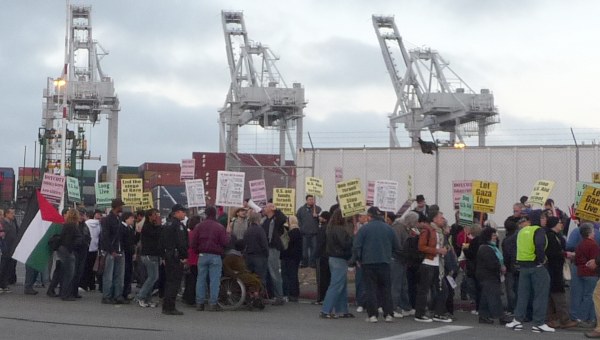
A third, more challenging example of a strategic approach to building working class unity against corporate power is seen in the rank-and-file movements within railroad worker unions which was able to gain a critical demand for paid sick leave that had appeared lost when the unions, under pressure from corporations and the Biden Administration, initially agreed to inadequate contracts. But two rank-and-file movements (one a multi-union movement, the other located within the largest rail union) developed a strategy working in cooperation with progressive caucus members of Congress, were able to win through pressure what had been lost at the bargaining table. Railroad accidents, in particular the disaster in East Palestine, Ohio, reinforced the connection workers were making: demands for increased staffing are also a demand for community safety.
As with the UAW and the Coalition of Unions at Kaiser Permanente, the rail workers won because of combining solidarity with a strategy rooted in understand where the corporations were vulnerable.18 But many outsiders failed to see that victory for what it was, failing in a sense to understand how political action and worker organizing can combine from the standpoint of organizing, when the organizing takes place from a position of relative weakness. More to the point, it is rooted in failing to understand the mutual dependence of workplace action and political mobilization in the wider public sphere. And this is crucial, for whatever gains are made in the current upsurge of labor action will prove ephemeral unless accompanied by a direct connection to political organizing rooted in mass mobilization and electoral action. The same holds true in reverse, elected officials and mass movements of protest will be unable to consolidate and move beyond protest without the structural power of organized labor acting to overcome the structural power of capital in defining and limiting social and economic rights.
After all union solidarity doesn’t automatically translate into solidarity around public education, affordable housing, criminal justice reform, universal health care, abortion rights (let alone opposition to war or support for environmental justice); that requires a fuller understanding of class. As Bill Fletcher (racial justice, labor and international activist, scholar and author) puts it in Labor Power, “Race and gender are not identity questions. They speak to a specific set of contradictions and forms of oppression that are central to actually existing capitalism.”19 Stresses that inhere in our social structures and within the capitalist system obscure that understanding.
This is where the need to create – both within labor and within political and social justice organizations, structures that are truly controlled and strategically directed by members, by impacted communities. A crucial component of that lies in education – not in the form of trainings or lectures (important as these can be in some contexts), but rather through participatory education, an underutilized form of organizing that expands mutual support by personalizing linkages that grow out of the experience and knowledge of those being engaged.
Melissa Shetler, from the Climate Jobs National Resource Center and Cornell’s Labor Leading on Climate Initiative, puts it in one of the most incisive essays from Labor Power:
“If we want an activated membership, we must practice a participatory democracy, and a participatory pedagogy, that will engage them. To develop leaders, or even better recognize and support already existing ones, we must engage workers in collective action in which they are valued, heard, and able to leverage their power. While identifying strategic choke points can indeed be effective, what was strategic today may not be strategic tomorrow. Without a broad analysis, organizers can spend all their time building power around a position that, in a swiftly evolving global economy, suddenly no longer exists. But if we build broader power, learn to be adaptive, and practice participatory democracy, we can construct new ways of being within the old structures that may ultimately generate momentum,” concluding, “successful pedagogy – and successful labor organizing – is community building.”20
Community building in this sense means forging a new sense of community as a political project that grounds multiracial democratic politics within the anti-corporate class politics of labor action; making multiracial politics a “lifestyle,” as Garza put it, bringing together social justice and economic justice organizing as distinct yet also intertwined spheres of engagement.21 Building union power also involves autonomous action to expand democratic rights; fighting to expand democratic rights means not only fighting the racist, fascist right, but fighting corporate power that structurally inhibits the exercise of popular power anywhere in society.
Such linkages need to be institutionalized, in a form that brings the insights – and the organizing upon which those insights have been developed – together in practice. With a final turn toward Power Concedes Nothing, we conclude with a passage by Maria Poblet, executive director of Grassroots Power Project, charting how those connections can be made.
“To win governing power, state-power-building groups need the capacities to design, drive the demand for, legislate, enact, and defend agendas for progressive reforms that serve the needs of low-income, working-class, and historically marginalized communities. In doing so, these power-building groups will not only help hold electeds accountable through their terms in office, but fundamentally reshape the structure of the government itself, creating the conditions for more authentic and multiracial democracy…
“… pathways to gaining governing power may be circuitous, with setbacks and side steps as well as opportunities to make forward leaps, along the way. We will continue to oppose bad government policies, and to fight the advance of authoritarianism and white nationalism. We show up, mobilize our bases, and defend our communities. At the same time, we want to see ourselves as, and start acting like, we can run things, we can co-govern, and beyond this, we can ultimately reshape governance, in our communities, in our states, and in our nation.
“With the goal of governing power as our compass, we use each arena of contestation as an opportunity to shift power, change the political climate, and take steps that get us closer to transforming governance. Electoral engagement is one of many arenas where we make these shifts, over time. This is the essence of what it means to build power in the states, through better aligned, coordinated work. This is what we are talking about when we talk about governing power.”22 •
Endnotes
- “Situating Womack,” by Glenn Perušek in John Womack Jr., Labor Power and Strategy, edited by Peter Olney and Glenn Perusek, PM Press, Oakland, 2023, pp 8-9.
- “Building and Transforming Power: Lessons from the 2020 Elections,” by Alicia Garza, Power Concedes Nothing, edited by Linda Burnham, Max Elbaum, Maria Poblet, editors, OR Books, New York/London, 2022, p 394.
- “The Foundry Interviews,” John Womack Jr. with Peter Olney in Womack Jr., op. cit., p 33.
- Ibid p 54.
- Ibid p 55.
- “No Magic Bullet: Technically Alone Strategic Power is Not Enough” by Katy Fox-Hodess, Ibid p 87. See also Jack Metzgar, “Associational Power, Too,” especially pp 95-96.
- “Domestic Workers Enter the Electoral Arena” by Linda Burnham and Ai-jen Poo, Burnham, Elbaum, Poblet, op. cit., pp 254-255.
- “Protest, Politics, and (Electoral) Power” by Maurice Mitchell, ibid. p 319.
- “Black Voters in 2020: A Roundtable Discussion,” with Sendolo Diaminah, Arisha Hatch, Thenjiwe McHarris and Mondale Robinson, moderated by Karl Kumodzi, Ibid. pp 147 – 148.
- Ibid, p 150. Bill Fletcher, in his contribution to Labor Power, uses Spartacus’ slave rebellion as a metaphor: “While he and his uprising failed, he placed himself within the people who were in motion,” and thus his near success, thus his legacy. Womack Jr, op. cit. p 75.
- “Thirty-Two Thousand Hogs and Not a Drop to Drink, by Gene Bruskin, Ibid. p, 126. See also Hog Wild by Lynn Waltz, University of Iowa Press, Iowa City, 2018 for a fuller description of the Smithfield campaign, especially pp 183 – 201.
- Bruskin, Ibid. p 127.
- The law referred to is SB 1070. See “LUCHA’s 10-Year Road Map to Victory,” by César Fierros Mendoza, in Burnham, Elbaum, Poblet, op cit. 49.
- Ibid. p 60.
- “Democratic Socialists and Presidential elections,” by David Duhalde, Ibid, p. 297. See also Duhalde’s “U.S. Elected Socialists Just Held their Largest Gathering in Nearly Forty Years,” In These Times.
- Ibid, p. 303.
- See Womack’s analysis of the strike “The UAW Strike, as of October 9, 2023,” in Stansbury Forum.
- See “Despite Controversy, Rail Workers are Winning Paid Sick Leave” by Paul Garver and Eli Gerzon, Working Mass, June 29, 2023. For an extended look at the power and limitation of rank-and-file upsurges in the absence of political space (and a strong organized left) see New York Longshoremen: Class and Power on the Docks by William J. Mello, University Press of Florida, Gainsville, 2010, especially pp 197 – 202.
- “Should Spartacus Have Organized the Roman Citizenry Rather Than the Slaves,” by Bill Fletcher Jr., in Womack Jr. op. cit. p 74.
- “Abandon the Banking Method!” by Melissa Shetler, in Womack Jr. op cit, p 117, p 118. For an example of that kind of leadership see Until I Am Free: Fannie Lou Hamer’s Enduring Message to America by Keisha N. Blain, Beacon Press, Boston, 2021, especially the description of her role at the 1964 Democratic National Convention and immediately thereafter in 1964, pp 53 – 57.
- Desmond Serrette notes that “We must develop a more sustained pro-democracy infrastructure that doesn’t depend on stridently racist and extremist opponents to make the case for a well-resourced, accessible election system” in “To Deepen Democracy Give Workers More Say,” Convergence Magazine, May 12, 2023.
- “States of Solidarity: How State Alignment Builds Multiracial Working-Class Power,” by Maria Poblet, Burnham, Elbaum, Poblet, op. cit. p 127.


